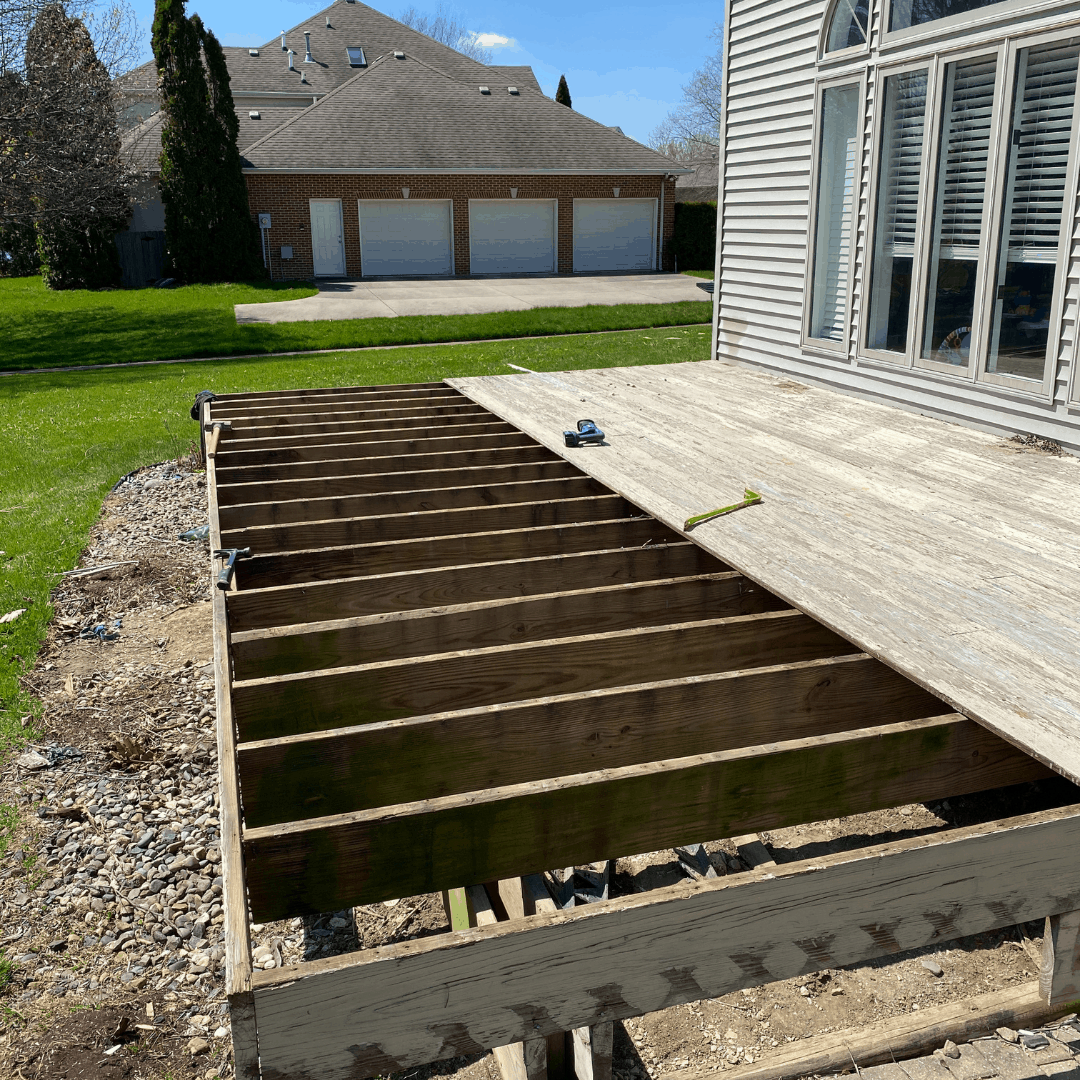Do you have a deck that needs maintenance beyond a simple pressure wash – but isn’t so damaged that it needs to be completely torn down? You may be in a situation to rebuild your deck.
Rebuilding a deck is a common project where I live in the Midwest. Homes often come with a deck that’s nice and large but also needs some attention. For example, my deck is 14′ x 24’ but wasn’t properly maintained over the years. It needed new decking materials along with some structure maintenance.
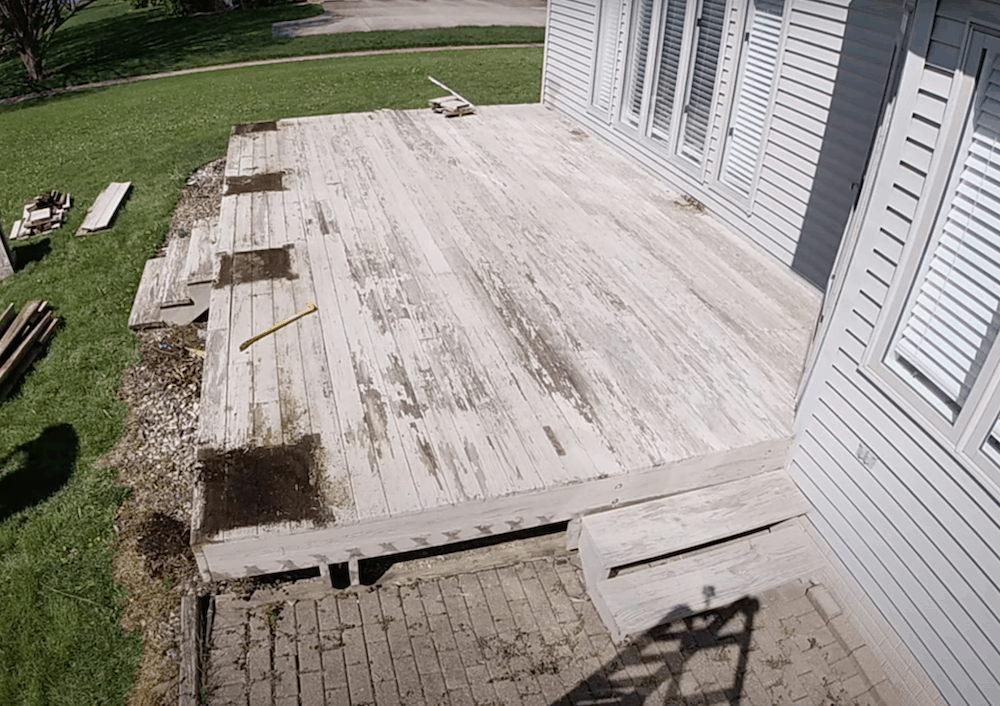

In this blog, I break down the entire rebuilding process into three phases: tearing off old deck materials, leveling the structure, and finally, laying the new decking boards. (If you’re more of a visual learner, I also added three videos from my Everyday Home Repairs YouTube Channel you can reference.)
Overall, rebuilding a deck cost me about $2,275. But keep reading for a full rundown of the process, the materials used, and the cost breakdown that you can adjust based on the size of your deck.
DISCLAIMER: This blog contains affiliate links, which means that if you click on one of the product links, I’ll receive a small commission.
Phase 1: Tear off old deck materials and dispose of them
The first phase focuses on tearing off the old materials and getting your deck ready, so you can put on new materials. During this phase not only will you be removing the old deck boards but you will be assessing the structure and starting to form your plan for phase 2 of this project.
Tools:
Note: You’ll also need access to a truck to dispose of the materials if you want to handle that yourself.
1. Remove deck materials
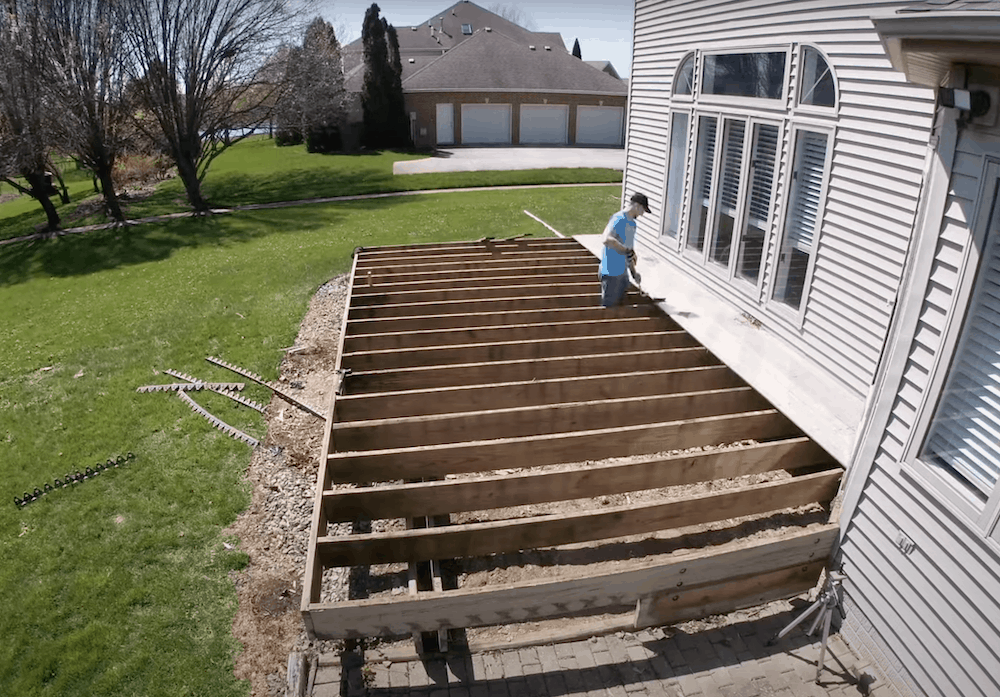
With your framing hammer, crowbar, sledgehammer, and Sawzall – take everything off the top of the deck. This includes the planter boxes, the seating, and all the decking. Personally, when removing the deck materials – I like to work at the ground level for a few rows of decking and then continue alternating back and forth.
2. Dispose of old materials

After you removed the pieces, you’ll need to get ready to dispose of them. To make this process easier, I broke the planter boxes down so I could lay them flat. That way, it’s less bulky to carry and it makes the most out of the bed space in the truck. From there, load up all the materials you need to dispose of into the bed of your truck and be sure to have your ratchet straps handy.
Finally, drop off the materials. If you’re wondering where to get rid of everything – you have two options.
- Option 1: Look for a Transfer Station in your neighborhood and rent a truck – or use your own – to drop it off yourself. Generally, this will be $75-$100 depending on where you live.
- Option 2: Look for metal scrappers. If you can find one of them and they have the truck, they’ll haul the material out (often for a reasonable price).
Pro tip: Be extra careful when you’re handling the wood and watch out for rusted nails that could dig into your hands or feet.
The overall cost of Phase 1: $175 on disposal fees. (I ended up making two trips)
Phase 2: Securing and leveling framing structure
In the second part, you’ll need to repair the joist and ensure your structure is solid and level. Often I have found the deck boards will take the most damage from weather while your joists will usually have another life left in them.
This is going to be different for everyone. But it’s critical to know that your framing structure is safe, secure, and level. If you’re dealing with a second-story deck – it’s going to be completely different. So be sure you understand and follow the local building code in your area. In my area if the deck surface is below 30″ off the ground you are not required to have handrails. Even though you might not install your handrails in phase 2 it is good to have a plan as you will want to install blocking and supports in phase 2 which will make phase 3 go smoother.
Tools:
While the majority of the wood was still good on our deck, I did tackle five issues:
- Replacing support post
- Swapping out damaged joists
- Replacing all rim joists
- Adding blocks between joists
- Leveling overall structure
Watch the video above for a deeper look at how I made these adjustments for an ultimately safer and more supported deck.
The overall cost of Phase 2: $250 on supplies.
Phase 3: Laying new deck boards
Now you’re at the final phase of giving your deck board a new life. Whew! In this third phase, you’ll be focused on placing new deck boards using a Camo screw system.
Tools:
- BoWrench (This will help you tremendously especially if your deck is large)
- Camo Pro (1/16inch gap) (I chose this as opposed to the 3/16” because the pressure treated deck boards used 3/16” – and I know it’s going to shrink as it dries and I don’t want a large gap)
- Camo 2 3/8 inch screws (700 count)
- Makita Corless Drill Combo Kit
- Wood Preservative Used on the end of your pressure treated boards after you make a cut
- Skilsaw
- Stanley Tape Measure
1. Take deck measurements
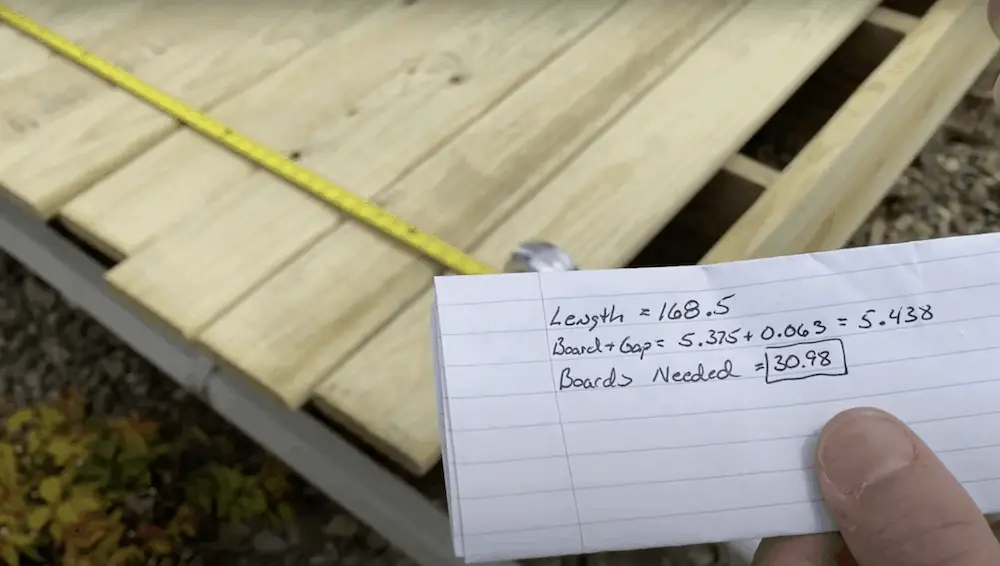
With a tape measurer, find out the distance from the vinyl on one end and then to the end of the rim joist. This will give you the distance you need to cover with boards. For me, this was 167.5.” I added 1” extra for the overhang.
- Length: 168.5″
- Board width + gap: 5.375″+.063″ = 5.438″
- Boards needed = 30.98
The goal is to have enough space with a sizable board so you can sink screws in and secure your last board with a 1.5″ overhang.
2. Place new deck boards
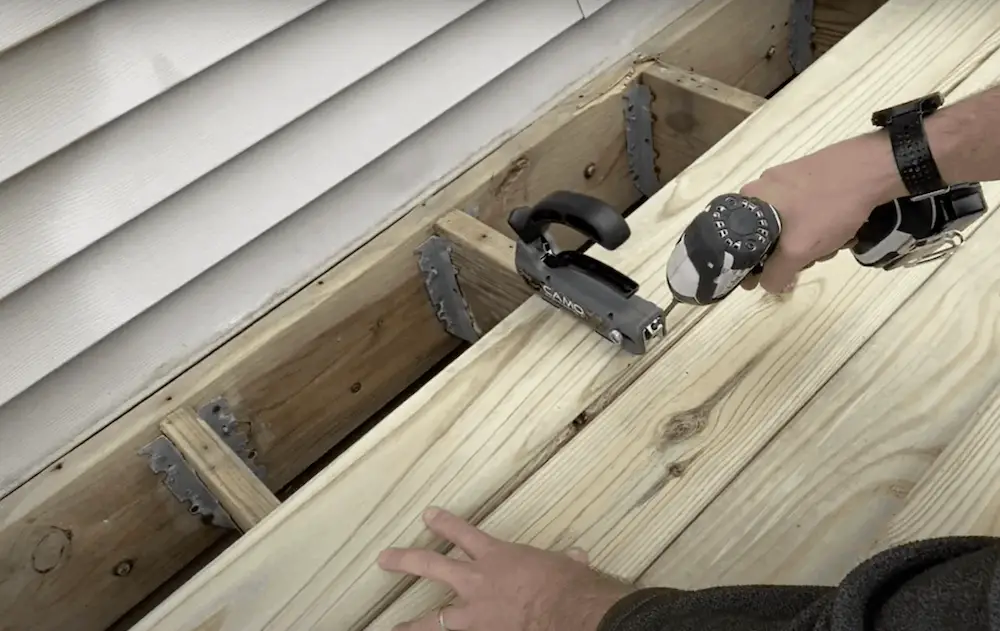
Begin placing the new deck boards. I started at the house side and took the second deck board off – and marked the joist. This is because the camo jig can’t fit on the first board because of the house. So, you’ll take the board out of place and sink the outside screw in- and just start it. Once you have all screws in place and started, then put the deck boards in position and sink the screws into the joist.
This is also where the BoWrench comes in handy, especially with long decks. You’ll find that when you’re working with a long wooden board, the further end tends to bow out. So this tool will give you leverage to straighten out the boards while maintaining a distance. (Go to 09:02 in the video above to see an example.)
Pro tip: Don’t have a BoWrench? You can make one. Grab a 3/4 inch square aluminum stock, and then hacksaw down to the height you need. Then, replicate the push system with bolts, lock nuts, and washers. It has worked for me in the past, but it might gauge up your boards a little more. If you need a little more info check out the video above where I will show you an example I made for a past deck project.
3. Secure the boards in place
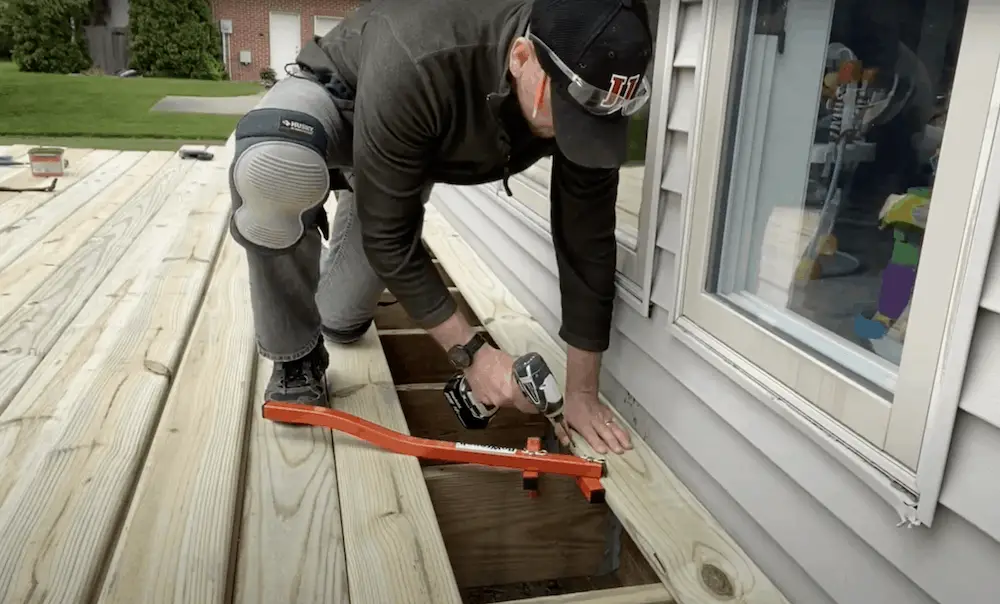
Using the camo jig and the BoWrench, place screws on both sides. And since the drill bed has a stop on it – you can’t drill them too far. Once the first board is in place, you’ll get into a rhythm.
Pro Tip: Push the board together as close as you can and don’t worry about leaving much of a gap if you are using pressure treated wood. Depending on the moisture content each board will shrink over the first 3 months of drying out. This will result in gaps naturally forming even if you had no gap at the start. Below is an example on my deck where the boards were first installed with no gap and now after the dry time have 1/4″ gap.
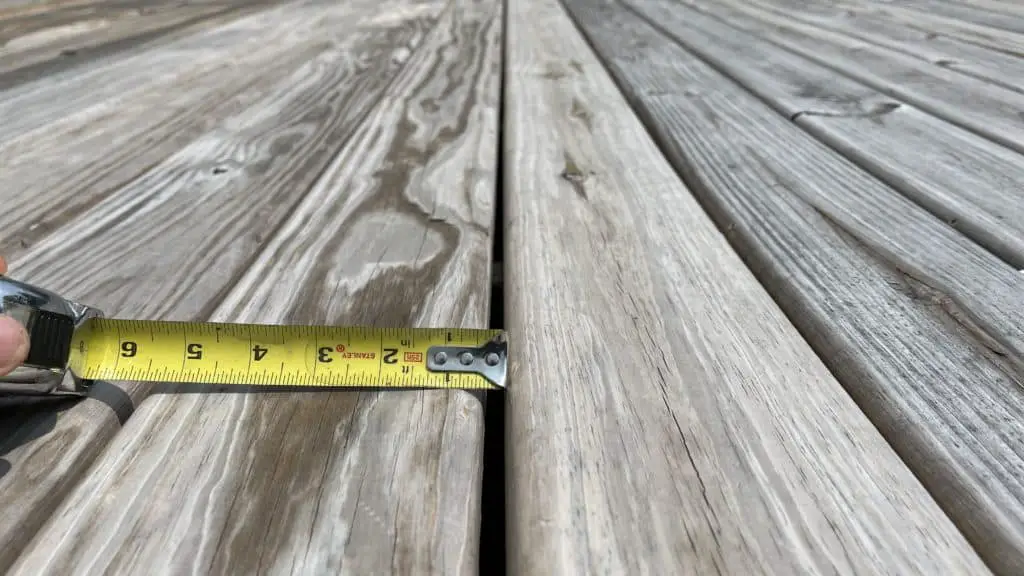
4. Even out the wood
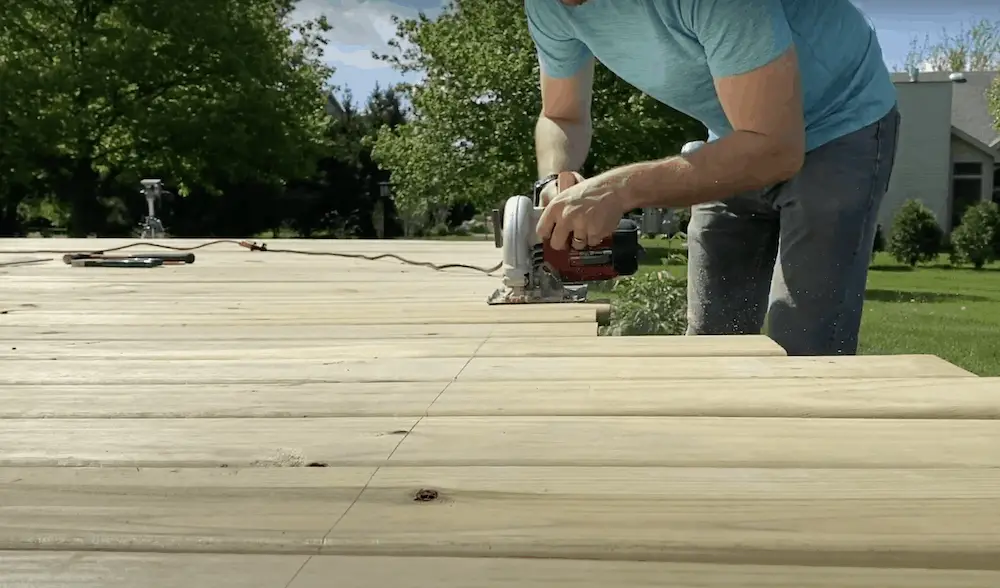
Once the boards are in place, you’ll see they have varying lengths. To even them out, you need to mark a straight line which is offset from your rim joist by 1.5″. I accomplished this by poking a larger trim nail up through the deck to mark the rim joist every 3 and a half feet. Then using the 4′ side of a T-square I reference the nails and marked my cut line which gave me a 1.5″ offset or overhange. (Go to 10:28 in the video to see how to do this.).
From here, make a straight line all the way down your boards with the help of your nails as guidance. Then, use a circular saw along the straight edge. You can freehand it or you can install a 2×4 and run the circular saw along the straight edge.
Pro tip: If you are using pressure treated wood cut your overhang at 2.5″ past the rim joist and let your deck dry for 3 months or so. Then come back through and recut your 1.5″ overhang since the boards will shrink at varying amounts and need dry time to settle at the final length. If you don’t do this your “straight cut line” will not be so straight after 1-3 months.
5. Treat the wood with a preservative
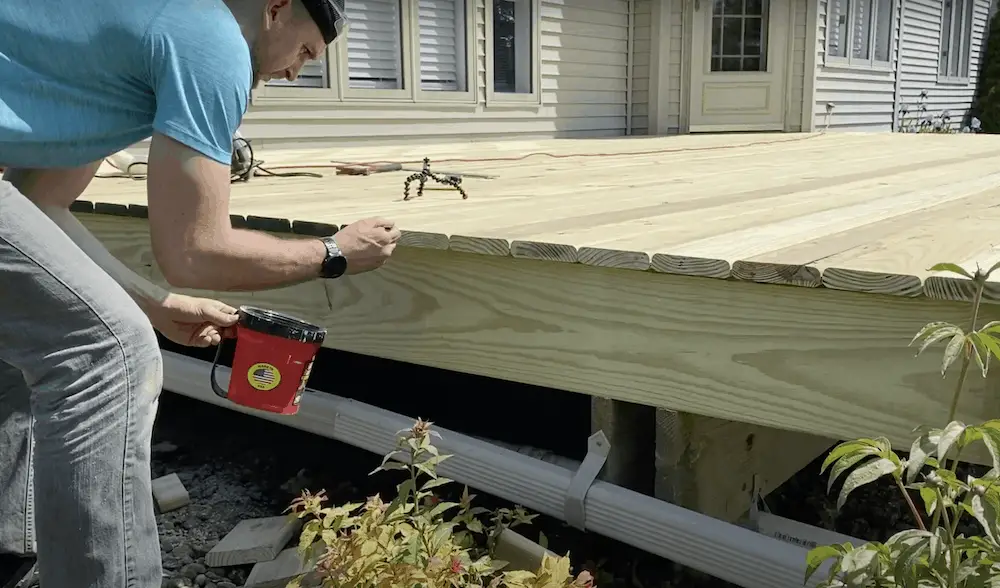
One final touch: When you cut an exposed end of each board, you’ll want to treat them with a wood life preservative. After you apply the preservative to the ends – your deck boards are good to go!
The overall cost of Phase 3: $1,850 on wood.
The Total Cost of Rebuilding a Deck
For the cost, as mentioned above, I spent a total of $2,275. Here’s a breakdown of where that money went:
- $175 on the disposal fees
- $100 on screws and hardware + $150 on the camo screws and the jig
- $50 on post-repair costs
- $1,800 on wood for the deck boards, rim joist, and additional joists
To sum it up, it was about $2,000 towards decking and $275 for getting the structure back in shape. Since my deck is 336 total square feet, the cost was about $6.75 per square foot.
So if you want to estimate your cost, I suggest measuring your deck to find the square footage and multiply it by $6.75. Hopefully, that gives you a rough estimate and perhaps gives you more context if you’re looking for quotes.
The Wrap Up
While I thought this deck renovation project would take a weekend of work, it ended up taking me longer. I spent a few hours during the following weeknights laying down floorboards. So it’s definitely a time-consuming and labor-intensive project. But for our family, the investment was well worth it for the enjoyment we get spending time outside.
I was also very pleased with the camo system. The finish is very smooth and I don’t have to deal with screws of varying depths at the top. But I do want to mention that there was one thing I did mess up: Even though I measured the distance between the vinyl and where I wanted the boards to overhang, by the time I had all my boards stretched out, I ended up having about 3/4″ of rim joist exposed. Though, I’m not too worried about it since I’m going to add planter boxes and stairs, and some other details. So far the deck is mostly where I want it to be!
Are you a new homeowner? Check out my list of 10 tools that every new homeowner needs! Here are more renovation projects to put on your radar:
